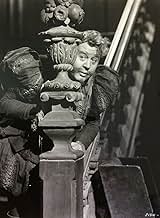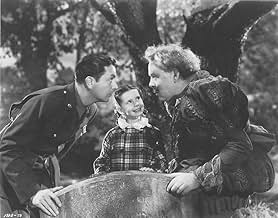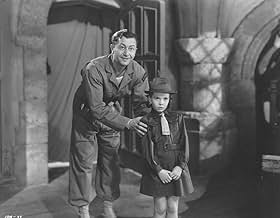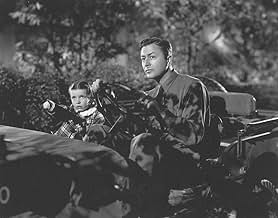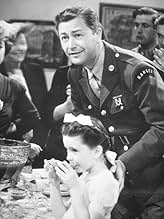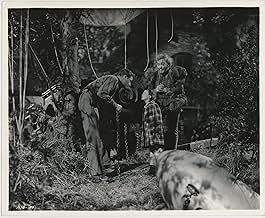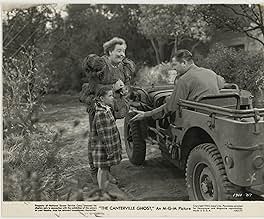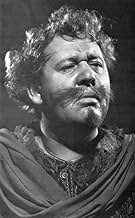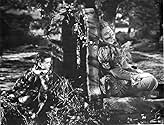AVALIAÇÃO DA IMDb
6,9/10
3,5 mil
SUA AVALIAÇÃO
Adicionar um enredo no seu idiomaThe descendent of a ghost imprisoned for cowardice hopes to free the spirit by displaying courage when under duress.The descendent of a ghost imprisoned for cowardice hopes to free the spirit by displaying courage when under duress.The descendent of a ghost imprisoned for cowardice hopes to free the spirit by displaying courage when under duress.
- Direção
- Roteiristas
- Artistas
- Prêmios
- 1 vitória no total
Rags Ragland
- Big Harry
- (as 'Rags' Ragland)
Harry Allen
- Mr. Cawthorne at Party
- (não creditado)
- Direção
- Roteiristas
- Elenco e equipe completos
- Produção, bilheteria e muito mais no IMDbPro
Avaliações em destaque
The veteran Charles Laughton and a very young Robert Young team up in this entertaining fantasy about the ghost of Simon de Canterville - condemned to haunt the halls of his family's castle until a descendant performs an act of bravery on his behalf. What's the catch? Simon was condemned by his own father for being a coward, and the Canterville line ever since has been a long line of cowards. (The greatest irony of the movie is that Simon has developed a reputation as the most fearsome ghost in all of England!) Finding a hero among this family won't be easy. Then along comes Cuffy Williams (Young), an American soldier whose platoon is billeted in the castle during the lead-up to D-Day. It turns out that Williams is a very distant descendant of the Cantervilles, and D-Day, of course, will provide the ultimate opportunity to show his bravery and to release Simon from his torment. The question is whether he'll be able to work up the courage to do it!
Laughton and Young offer excellent performances, and the very young Margaret O'Brien (who would have been about 7 when this was made) is convincing as Lady Jessica de Canterville. Some of the scenes as the American soldiers try to chase down the ghost to get a picture of him to prove that he exists to their commanding officer are also quite funny. 8/10
Laughton and Young offer excellent performances, and the very young Margaret O'Brien (who would have been about 7 when this was made) is convincing as Lady Jessica de Canterville. Some of the scenes as the American soldiers try to chase down the ghost to get a picture of him to prove that he exists to their commanding officer are also quite funny. 8/10
Margaret O'Brien tries to help one of her long-dead ancestors in "The Canterville Ghost," a 1944 film also starring Charles Laughton, Robert Young, and Frank Faylen. Jessica de Canterville's (O'Brien) family owns a castle which is being used to house soldiers during their stay in the area. The castle has a very famous ghost named Sir Simon de Canterville (Charles Laughton) whose father had him imprisoned inside a wall for cowardice centuries earlier. Simon roams the castle, looking like the Cowardly Lion in royal costume. The only way he can rest for eternity is if a relative performs a courageous act in his name, i.e., by taking his signet ring and wearing it when he does the brave thing. Alas, the entire family for centuries has run the other way when danger appears, so Simon isn't having any luck. When six-year-old Lady Jessica de Canterville realizes that one of the soldiers is related to her, she begs him to help poor, tired Simon.
This is a wonderful movie, buoyed by the presence of Margaret O'Brien, surely one of the most adorable children to ever hit the screen. She's a fine actress, too - very sincere and natural. Although Mary Astor wrote in her diary that she was terrified of O'Brian during the filming of "Meet Me in St. Louis," it's kind of hard to believe. Charles Laughton turns in another masterful performance as Simon, who scares people because he thinks that as a ghost, it's what he should do. He's a riot. As Cuffy Williams, the soldier related to Jessica and Simon, Robert Young is very good as a man who begins to doubt his own courage.
"The Canterville Ghost" is loads of fun for the entire family, with plenty of comedy and some nice lessons, one of which is, when you really want something, you often need patience until you achieve it.
This is a wonderful movie, buoyed by the presence of Margaret O'Brien, surely one of the most adorable children to ever hit the screen. She's a fine actress, too - very sincere and natural. Although Mary Astor wrote in her diary that she was terrified of O'Brian during the filming of "Meet Me in St. Louis," it's kind of hard to believe. Charles Laughton turns in another masterful performance as Simon, who scares people because he thinks that as a ghost, it's what he should do. He's a riot. As Cuffy Williams, the soldier related to Jessica and Simon, Robert Young is very good as a man who begins to doubt his own courage.
"The Canterville Ghost" is loads of fun for the entire family, with plenty of comedy and some nice lessons, one of which is, when you really want something, you often need patience until you achieve it.
This review is somewhat biased, as I am an avid Robert Young fan, and have yet to see him in a less than stellar performance. Margaret O'Brien is also splendid, and it is hard to believe so much talent projects out of a six year old girl. Charles Laughton is memorable in his fine delivery of both pathos and comedic skills.
A highlight of the film for me is the music played by the G.I.s. at a local party. Music is classic 40's 8 to the bar, visually punctuated with awesome jitterbugging by the soldiers. A proper female British spectator comments to an incredulous priest, "I believe they call it woogie boogie." It is unknown what what the song title or who the recording artists may have been, however credits list original music for the film as provided by George Bassman.
A highlight of the film for me is the music played by the G.I.s. at a local party. Music is classic 40's 8 to the bar, visually punctuated with awesome jitterbugging by the soldiers. A proper female British spectator comments to an incredulous priest, "I believe they call it woogie boogie." It is unknown what what the song title or who the recording artists may have been, however credits list original music for the film as provided by George Bassman.
Charles Laughton who made a career of playing tortured and twisted men goes one better here as Sir Simon de Canterville who haunts stately Canterville Manor until another Canterville performs a heroic deed and frees him from being earthbound.
The first part of the film shows the incident where Sir Simon turns tail and runs from a duel he got involved in. Out of shame and embarrassment, his father bricked him up in a room in the manor and pronounced the aforementioned curse upon him.
Breaking that curse is easier said than done because the cowardice was passed down several generations from Stuart England to World War II.
Enter a platoon of American rangers quartered at the manor house where the current lady of the manor, Margaret O'Brien is like so many in Great Britain in those years, playing host to American GIs. One in that platoon is a distant cousin from America, Robert Young. Will he perform the deed that frees Charles Laughton? Watch the film and find out.
Robert Young and Margaret O'Brien are fine, but it is the multi-talented Mr. Laughton who carries this film. This is a difficult part and only an actor of real talent and skill could carry it off. The comic elements are nicely done, but Laughton also has to project an air of resigned sadness at the fate he's been cursed with. And Mr. Laughton bares the tortured soul of Simon de Canterville for all to see.
This is a story originally written by Oscar Wilde and nicely updated for World War II moviegoers. And it's still a fine piece of film making for today's audience.
The first part of the film shows the incident where Sir Simon turns tail and runs from a duel he got involved in. Out of shame and embarrassment, his father bricked him up in a room in the manor and pronounced the aforementioned curse upon him.
Breaking that curse is easier said than done because the cowardice was passed down several generations from Stuart England to World War II.
Enter a platoon of American rangers quartered at the manor house where the current lady of the manor, Margaret O'Brien is like so many in Great Britain in those years, playing host to American GIs. One in that platoon is a distant cousin from America, Robert Young. Will he perform the deed that frees Charles Laughton? Watch the film and find out.
Robert Young and Margaret O'Brien are fine, but it is the multi-talented Mr. Laughton who carries this film. This is a difficult part and only an actor of real talent and skill could carry it off. The comic elements are nicely done, but Laughton also has to project an air of resigned sadness at the fate he's been cursed with. And Mr. Laughton bares the tortured soul of Simon de Canterville for all to see.
This is a story originally written by Oscar Wilde and nicely updated for World War II moviegoers. And it's still a fine piece of film making for today's audience.
This, the first film version of Oscar Wilde's short story "The Canterville Ghost", was made by M-G-M during World War II, and, like some other films of that period based on literary or theatrical works, tries to incorporate some good old American (and British) flag-waving into its charming original story, which, as in all the TV versions (this is the only theatrical one) updates it to the twentieth century; when will someone do a good film version of the story in its original, nineteenth-century setting?
Fortunately, the story isn't tampered with enough to ruin it, and one of the film's virtues is Charles Laughton in the title role.
Proving what a great actor can bring to an average screenplay, Laughton hams it up outrageously in his comical first scene, in which his character, Sir Simon de Canterville, is still alive, but he later shows a deep sensitivity in the later scenes in which he expresses terror during his murder and quiet despair at his fate.
In order to incorporate some war heroics, a platoon of American soldiers has been incorporated into the story, and Laughton's descendant (Robert Young) must perform a heroic deed in order to break the curse that Laughton has been placed under. Some rather broad serviceman comedy has been incorporated into the story as well, courtesy of "Rags" Ragland and Frank Faylen (Dobie Gillis's dad on the TV series). It is Faylen who gets to deliver the film's most topical line--not having seen the ghost yet, he asks his fearful platoon, "What are you going to do when you have to face Nazis?" (What would Oscar Wilde have thought?)
Robert Young is his usual pleasant self as Laughton's descendant, and child star Margaret O'Brien isn't nearly as revoltingly syrupy as you might fear.
But it is Laughton's way with both sentiment and comedy that really makes the film worth watching, and it is worth watching.
Fortunately, the story isn't tampered with enough to ruin it, and one of the film's virtues is Charles Laughton in the title role.
Proving what a great actor can bring to an average screenplay, Laughton hams it up outrageously in his comical first scene, in which his character, Sir Simon de Canterville, is still alive, but he later shows a deep sensitivity in the later scenes in which he expresses terror during his murder and quiet despair at his fate.
In order to incorporate some war heroics, a platoon of American soldiers has been incorporated into the story, and Laughton's descendant (Robert Young) must perform a heroic deed in order to break the curse that Laughton has been placed under. Some rather broad serviceman comedy has been incorporated into the story as well, courtesy of "Rags" Ragland and Frank Faylen (Dobie Gillis's dad on the TV series). It is Faylen who gets to deliver the film's most topical line--not having seen the ghost yet, he asks his fearful platoon, "What are you going to do when you have to face Nazis?" (What would Oscar Wilde have thought?)
Robert Young is his usual pleasant self as Laughton's descendant, and child star Margaret O'Brien isn't nearly as revoltingly syrupy as you might fear.
But it is Laughton's way with both sentiment and comedy that really makes the film worth watching, and it is worth watching.
Você sabia?
- CuriosidadesThe bomb that Cuffy and the ghost want to dispose of was known as a "blockbuster", so-called because it was so powerful it could demolish more than a dozen buildings i.e. a city block.
- Erros de gravaçãoWhile many German parachute mines with time delay dropped on England during World War II; but they weren't called blockbusters. The blockbuster was a type of bomb devised by the British. At first a blockbuster was a four thousand pound bomb; but later became an 8000 and then a 12000 pound bomb. They achieved these sizes by simply bolting two or three of the 4000 pounders together. They were called Blockbusters because it was calculated that they could destroy a city block.
- Citações
Sir Simon de Canterville: Excuse me, I really must gibber at the oriole window.
- ConexõesFeatured in Cineficción Radio: Lo fantástico (2020)
- Trilhas sonorasBless 'em All
(uncredited)
Written by Fred Godfrey (1917)
Revised lyrics by Jimmy Hughes and Frank Lake (1940)
Additional lyrics by Al Stillman (1941)
Sung a cappella by the soldiers
Principais escolhas
Faça login para avaliar e ver a lista de recomendações personalizadas
- How long is The Canterville Ghost?Fornecido pela Alexa
Detalhes
- Data de lançamento
- País de origem
- Idioma
- Também conhecido como
- El fantasma de Canterville
- Locações de filme
- Empresa de produção
- Consulte mais créditos da empresa na IMDbPro
- Tempo de duração
- 1 h 35 min(95 min)
- Cor
- Proporção
- 1.37 : 1
Contribua para esta página
Sugerir uma alteração ou adicionar conteúdo ausente



